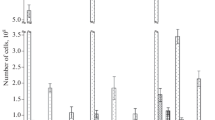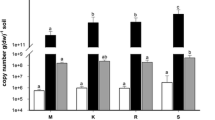The succession of bacterial communities inhabiting the forefield of the Dammaglacier (Switzerland) was investigated in soils ranging in successional age from 0 to 100 years since deglaciation. Overall activity per bacterial cell was estimated by the amount of fluorescein diacetate (FDA) hydrolyzed per DAPI-stained cell, and an index of "opportunism" was determined from the ratio of culturable to total cells (C:T ratio). Ribosomal intergenic spacer analysis (RISA) was used to estimate the richness of dominant phylotypes and to construct rank-abundance plots of the dominant populations. We observed a biphasic trend in specific cellular activity, which exhibited minima in the 0- and 100-year-old soils while a maximum activity per cell was reached in the 70-y soil. On average, the C:T ratio showed the same trend as the specific activity, although we observed some differences between the two sampling transects. RISA revealed a decrease in dominant phylotype richness as successional age increased, and rank-abundance plots indicated that the evenness of the dominant bacterial phylotypes significantly decreased with successional age. The combination of specific cellular activity and C:T ratio results suggested the presence of an r-K continuum of bacteria while RISA showed that richness and evenness of dominant phylotypes decreased with successional age. We conclude that bacterial succession in the glacier forefield was a dynamic process with adaptation to the differing stages of succession occurring on both the individual and community levels.
Similar content being viewed by others
Author information
Authors and Affiliations
Rights and permissions
About this article
Cite this article
Sigler, W., Crivii, S. & Zeyer, J. Bacterial Succession in Glacial Forefield Soils Characterized by Community Structure, Activity and Opportunistic Growth Dynamics . Microb Ecol 44, 306–316 (2002). https://doi.org/10.1007/s00248-002-2025-9
Received:
Accepted:
Issue Date:
DOI: https://doi.org/10.1007/s00248-002-2025-9




